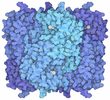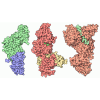+ データを開く
データを開く
- 基本情報
基本情報
| 登録情報 |  | |||||||||||||||
|---|---|---|---|---|---|---|---|---|---|---|---|---|---|---|---|---|
| タイトル | Alzheimer's disease PHF complexed with PET ligand MK-6240 | |||||||||||||||
 マップデータ マップデータ | ||||||||||||||||
 試料 試料 |
| |||||||||||||||
 キーワード キーワード | MK-6240 PET Ligand / AD PHF / PROTEIN FIBRIL | |||||||||||||||
| 機能・相同性 |  機能・相同性情報 機能・相同性情報plus-end-directed organelle transport along microtubule / histone-dependent DNA binding / negative regulation of establishment of protein localization to mitochondrion / neurofibrillary tangle / microtubule lateral binding / main axon / axonal transport / tubulin complex / positive regulation of protein localization to synapse / phosphatidylinositol bisphosphate binding ...plus-end-directed organelle transport along microtubule / histone-dependent DNA binding / negative regulation of establishment of protein localization to mitochondrion / neurofibrillary tangle / microtubule lateral binding / main axon / axonal transport / tubulin complex / positive regulation of protein localization to synapse / phosphatidylinositol bisphosphate binding / negative regulation of tubulin deacetylation / generation of neurons / regulation of chromosome organization / rRNA metabolic process / axonal transport of mitochondrion / regulation of mitochondrial fission / axon development / regulation of long-term synaptic depression / central nervous system neuron development / intracellular distribution of mitochondria / regulation of microtubule polymerization / microtubule polymerization / lipoprotein particle binding / minor groove of adenine-thymine-rich DNA binding / negative regulation of mitochondrial membrane potential / dynactin binding / apolipoprotein binding / axolemma / protein polymerization / glial cell projection / negative regulation of mitochondrial fission / Caspase-mediated cleavage of cytoskeletal proteins / regulation of microtubule polymerization or depolymerization / positive regulation of axon extension / neurofibrillary tangle assembly / Activation of AMPK downstream of NMDARs / regulation of cellular response to heat / supramolecular fiber organization / synapse assembly / positive regulation of protein localization / cellular response to brain-derived neurotrophic factor stimulus / somatodendritic compartment / regulation of calcium-mediated signaling / cytoplasmic microtubule organization / positive regulation of microtubule polymerization / axon cytoplasm / stress granule assembly / phosphatidylinositol binding / regulation of microtubule cytoskeleton organization / nuclear periphery / protein phosphatase 2A binding / positive regulation of superoxide anion generation / cellular response to reactive oxygen species / astrocyte activation / Hsp90 protein binding / microglial cell activation / response to lead ion / cellular response to nerve growth factor stimulus / synapse organization / PKR-mediated signaling / protein homooligomerization / regulation of synaptic plasticity / SH3 domain binding / memory / microtubule cytoskeleton organization / cytoplasmic ribonucleoprotein granule / neuron projection development / cell-cell signaling / single-stranded DNA binding / protein-folding chaperone binding / actin binding / cellular response to heat / microtubule cytoskeleton / cell body / growth cone / double-stranded DNA binding / protein-macromolecule adaptor activity / microtubule binding / dendritic spine / sequence-specific DNA binding / amyloid fibril formation / microtubule / learning or memory / neuron projection / regulation of autophagy / membrane raft / axon / negative regulation of gene expression / neuronal cell body / dendrite / DNA damage response / protein kinase binding / enzyme binding / mitochondrion / DNA binding / RNA binding / extracellular region / identical protein binding / nucleus / plasma membrane 類似検索 - 分子機能 | |||||||||||||||
| 生物種 |  Homo sapiens (ヒト) Homo sapiens (ヒト) | |||||||||||||||
| 手法 | らせん対称体再構成法 / クライオ電子顕微鏡法 / 解像度: 2.31 Å | |||||||||||||||
 データ登録者 データ登録者 | Kunach P / Shahmoradian SH / Diamond MI / Rosa-Neto P | |||||||||||||||
| 資金援助 |  米国, 米国,  カナダ, 4件 カナダ, 4件
| |||||||||||||||
 引用 引用 |  ジャーナル: Nat Commun / 年: 2024 ジャーナル: Nat Commun / 年: 2024タイトル: Cryo-EM structure of Alzheimer's disease tau filaments with PET ligand MK-6240. 著者: Peter Kunach / Jaime Vaquer-Alicea / Matthew S Smith / Jim Monistrol / Robert Hopewell / Luc Moquin / Joseph Therriault / Cecile Tissot / Nesrine Rahmouni / Gassan Massarweh / Jean-Paul Soucy ...著者: Peter Kunach / Jaime Vaquer-Alicea / Matthew S Smith / Jim Monistrol / Robert Hopewell / Luc Moquin / Joseph Therriault / Cecile Tissot / Nesrine Rahmouni / Gassan Massarweh / Jean-Paul Soucy / Marie-Christine Guiot / Brian K Shoichet / Pedro Rosa-Neto / Marc I Diamond / Sarah H Shahmoradian /  要旨: Positron Emission Tomography (PET) ligands have advanced Alzheimer's disease (AD) diagnosis and treatment. Using autoradiography and cryo-EM, we identify AD brain tissue with elevated tau burden, ...Positron Emission Tomography (PET) ligands have advanced Alzheimer's disease (AD) diagnosis and treatment. Using autoradiography and cryo-EM, we identify AD brain tissue with elevated tau burden, purify filaments, and determine the structure of second-generation high avidity PET ligand MK-6240 at 2.31 Å resolution, which bound at a 1:1 ratio within the cleft of tau paired-helical filament (PHF), engaging with glutamine 351, lysine 353, and isoleucine 360. This information elucidates the basis of MK-6240 PET in quantifying PHF deposits in AD and may facilitate the structure-based design of superior ligands against tau amyloids. #1:  ジャーナル: Biorxiv / 年: 2023 ジャーナル: Biorxiv / 年: 2023タイトル: Alzheimer's disease PHF complexed with PET ligand MK-6240 著者: Kunach P / Shahmoradian SH / Diamond MI / Rosa-Neto P | |||||||||||||||
| 履歴 |
|
- 構造の表示
構造の表示
| 添付画像 |
|---|
- ダウンロードとリンク
ダウンロードとリンク
-EMDBアーカイブ
| マップデータ |  emd_42463.map.gz emd_42463.map.gz | 20.2 MB |  EMDBマップデータ形式 EMDBマップデータ形式 | |
|---|---|---|---|---|
| ヘッダ (付随情報) |  emd-42463-v30.xml emd-42463-v30.xml emd-42463.xml emd-42463.xml | 17.8 KB 17.8 KB | 表示 表示 |  EMDBヘッダ EMDBヘッダ |
| FSC (解像度算出) |  emd_42463_fsc.xml emd_42463_fsc.xml | 12 KB | 表示 |  FSCデータファイル FSCデータファイル |
| 画像 |  emd_42463.png emd_42463.png | 52.4 KB | ||
| マスクデータ |  emd_42463_msk_1.map emd_42463_msk_1.map | 149.9 MB |  マスクマップ マスクマップ | |
| Filedesc metadata |  emd-42463.cif.gz emd-42463.cif.gz | 5.5 KB | ||
| その他 |  emd_42463_half_map_1.map.gz emd_42463_half_map_1.map.gz emd_42463_half_map_2.map.gz emd_42463_half_map_2.map.gz | 118.2 MB 118.3 MB | ||
| アーカイブディレクトリ |  http://ftp.pdbj.org/pub/emdb/structures/EMD-42463 http://ftp.pdbj.org/pub/emdb/structures/EMD-42463 ftp://ftp.pdbj.org/pub/emdb/structures/EMD-42463 ftp://ftp.pdbj.org/pub/emdb/structures/EMD-42463 | HTTPS FTP |
-検証レポート
| 文書・要旨 |  emd_42463_validation.pdf.gz emd_42463_validation.pdf.gz | 983.5 KB | 表示 |  EMDB検証レポート EMDB検証レポート |
|---|---|---|---|---|
| 文書・詳細版 |  emd_42463_full_validation.pdf.gz emd_42463_full_validation.pdf.gz | 983.1 KB | 表示 | |
| XML形式データ |  emd_42463_validation.xml.gz emd_42463_validation.xml.gz | 19.7 KB | 表示 | |
| CIF形式データ |  emd_42463_validation.cif.gz emd_42463_validation.cif.gz | 26 KB | 表示 | |
| アーカイブディレクトリ |  https://ftp.pdbj.org/pub/emdb/validation_reports/EMD-42463 https://ftp.pdbj.org/pub/emdb/validation_reports/EMD-42463 ftp://ftp.pdbj.org/pub/emdb/validation_reports/EMD-42463 ftp://ftp.pdbj.org/pub/emdb/validation_reports/EMD-42463 | HTTPS FTP |
-関連構造データ
| 関連構造データ |  8uq7MC M: このマップから作成された原子モデル C: 同じ文献を引用 ( |
|---|---|
| 類似構造データ | 類似検索 - 機能・相同性  F&H 検索 F&H 検索 |
- リンク
リンク
| EMDBのページ |  EMDB (EBI/PDBe) / EMDB (EBI/PDBe) /  EMDataResource EMDataResource |
|---|---|
| 「今月の分子」の関連する項目 |
- マップ
マップ
| ファイル |  ダウンロード / ファイル: emd_42463.map.gz / 形式: CCP4 / 大きさ: 149.9 MB / タイプ: IMAGE STORED AS FLOATING POINT NUMBER (4 BYTES) ダウンロード / ファイル: emd_42463.map.gz / 形式: CCP4 / 大きさ: 149.9 MB / タイプ: IMAGE STORED AS FLOATING POINT NUMBER (4 BYTES) | ||||||||||||||||||||||||||||||||||||
|---|---|---|---|---|---|---|---|---|---|---|---|---|---|---|---|---|---|---|---|---|---|---|---|---|---|---|---|---|---|---|---|---|---|---|---|---|---|
| 投影像・断面図 | 画像のコントロール
画像は Spider により作成 | ||||||||||||||||||||||||||||||||||||
| ボクセルのサイズ | X=Y=Z: 0.83 Å | ||||||||||||||||||||||||||||||||||||
| 密度 |
| ||||||||||||||||||||||||||||||||||||
| 対称性 | 空間群: 1 | ||||||||||||||||||||||||||||||||||||
| 詳細 | EMDB XML:
|
-添付データ
-マスク #1
| ファイル |  emd_42463_msk_1.map emd_42463_msk_1.map | ||||||||||||
|---|---|---|---|---|---|---|---|---|---|---|---|---|---|
| 投影像・断面図 |
| ||||||||||||
| 密度ヒストグラム |
- 試料の構成要素
試料の構成要素
-全体 : Microtubule-associated protein tau
| 全体 | 名称: Microtubule-associated protein tau |
|---|---|
| 要素 |
|
-超分子 #1: Microtubule-associated protein tau
| 超分子 | 名称: Microtubule-associated protein tau / タイプ: tissue / ID: 1 / 親要素: 0 / 含まれる分子: #1 |
|---|---|
| 由来(天然) | 生物種:  Homo sapiens (ヒト) Homo sapiens (ヒト) |
-分子 #1: Microtubule-associated protein tau
| 分子 | 名称: Microtubule-associated protein tau / タイプ: protein_or_peptide / ID: 1 / コピー数: 6 / 光学異性体: LEVO |
|---|---|
| 由来(天然) | 生物種:  Homo sapiens (ヒト) Homo sapiens (ヒト) |
| 分子量 | 理論値: 8.184412 KDa |
| 配列 | 文字列: SVQIVYKPVD LSKVTSKCGS LGNIHHKPGG GQVEVKSEKL DFKDRVQSKI GSLDNITHVP GGGNKKIETH KLTFR UniProtKB: Microtubule-associated protein tau |
-分子 #2: 6-fluoro-3-(1H-pyrrolo[2,3-c]pyridin-1-yl)isoquinolin-5-amine
| 分子 | 名称: 6-fluoro-3-(1H-pyrrolo[2,3-c]pyridin-1-yl)isoquinolin-5-amine タイプ: ligand / ID: 2 / コピー数: 6 / 式: X6R |
|---|---|
| 分子量 | 理論値: 278.284 Da |
-実験情報
-構造解析
| 手法 | クライオ電子顕微鏡法 |
|---|---|
 解析 解析 | らせん対称体再構成法 |
| 試料の集合状態 | filament |
- 試料調製
試料調製
| 緩衝液 | pH: 7.4 |
|---|---|
| グリッド | モデル: UltrAuFoil R1.2/1.3 / 材質: COPPER / メッシュ: 300 |
| 凍結 | 凍結剤: ETHANE / チャンバー内湿度: 100 % / チャンバー内温度: 19 K / 装置: FEI VITROBOT MARK IV |
- 電子顕微鏡法
電子顕微鏡法
| 顕微鏡 | FEI TITAN KRIOS |
|---|---|
| 特殊光学系 | エネルギーフィルター - 名称: GIF Bioquantum / エネルギーフィルター - スリット幅: 20 eV |
| 撮影 | フィルム・検出器のモデル: GATAN K3 (6k x 4k) / 撮影したグリッド数: 1 / 実像数: 8037 / 平均露光時間: 5.4 sec. / 平均電子線量: 1.0 e/Å2 |
| 電子線 | 加速電圧: 300 kV / 電子線源:  FIELD EMISSION GUN FIELD EMISSION GUN |
| 電子光学系 | C2レンズ絞り径: 70.0 µm / 倍率(補正後): 105000 / 照射モード: FLOOD BEAM / 撮影モード: BRIGHT FIELD / 最大 デフォーカス(公称値): 2.2 µm / 最小 デフォーカス(公称値): 0.8 µm |
| 試料ステージ | 試料ホルダーモデル: FEI TITAN KRIOS AUTOGRID HOLDER ホルダー冷却材: NITROGEN |
| 実験機器 |  モデル: Titan Krios / 画像提供: FEI Company |
 ムービー
ムービー コントローラー
コントローラー









 Z (Sec.)
Z (Sec.) Y (Row.)
Y (Row.) X (Col.)
X (Col.)





























